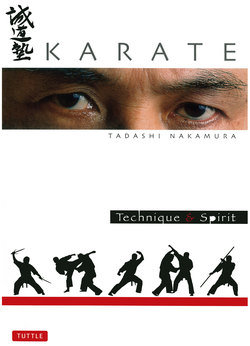Читать книгу Karate Technique & Spirit - Tadashi Nakamura - Страница 10
ОглавлениеINTRODUCTION
Karate is more popular now than ever before in its history. Because of the movies, television and magazines, karate is widely perceived as a purely physical art, with spinning kicks and “karate chops.” Karate has also become competitive on the amateur and professional levels, with individual promoters and organizations striving to control this fast-growing sport. Karate certainly develops strength, stamina and physical well-being, which are all desirable objectives. However, this is not the heart of karate-do.
Karate is a way of life, a way of being. I have committed over 30 years of my life to the study, practice and teaching of the martial arts. I am convinced that karate has much to offer modern men, women and children, as we move forward into the twenty-first century. My purpose in writing this book is to show what I feel is the true essence, the kernel of true karate-do: the training of body, mind and spirit together in order to realize the fullness of human potential.
Since the origins of karate are intimately intertwined with Zen, I have included one chapter on the history and philosophy of karate and Zen. I hope that this will be of interest to all martial arts students, as well as to students of Oriental thought and culture. Understanding the roots of karate can help to make a student’s practice more meaningful.
Since the formalities and etiquette of karate have been largely forgotten in current practice, I have chosen to emphasize these in this book. Formality and ritual courtesy are not important in and of themselves. Rather, through repetition and practice, they help to cultivate a sense of self-awareness and a sensitivity to the feelings of others. These are the marks of a truly civilized person, a true karate-ka.
The technical chapters of the book explain in detail the basic physical aspects of karate: warming up, stretching, diet, training principles, stances, basic blocks, kicks and punches. The chapter on kata and weapons practice include material for advanced students. Whatever style of martial art you the reader, may study, I hope that this instructional material will help to refine and improve your physical practice.
The way of karate must be experienced by each individual in his or her own unique way. In this I have used the photos along with the text to convey a feeling for karate-do in the setting of daily life. Karate-do is not a sport. There is no competition with others. The real competition is with the self.
Karate-do, like life, which it mirrors, is a struggle: a struggle with our own weakness, with our egos and our selfishness, with our narrow-mindedness and prejudices. Growth in the way of karate come through unceasing, repetitive daily practice of the basics. This is called ren ma (constant polishing). Modern society frowns on repetition as being stifling and boring. The discipline of single-minded repetition is at the heart of karate-do. Through it, we can quiet the inner dialogue between the ego and the intellect, and we can find true freedom. There are no shortcuts to anything of lasting value. Karate-do aims at the highest perfection of the individual in the physical, spiritual and mental dimensions.
The last chapter contains a selection of short lectures that I have delivered to my students on a weekly basis over the years. The lectures deal with the simple, basic truths that form the moral foundation of true karate-do. This moral and ethical foundation is also something that has been ignored. A true karate-ka is a person who takes his or her training in the dojo and applies it in the outside world, using the highest moral standards. Thus the karate-ka strives to be the best student, worker, husband, wife, parent or child possible. I offer these lectures to you, the reader, in the sincere hope that you may find some value in them.
I formed the World Seido Karate Organization in 1976 because I felt strongly that if karate was to survive into the twenty-first century, it must first rediscover its fullness and true essence.
In Seido, I emphasize strict discipline, respect and courtesy, and sincere practice, along with hard physical training. While each student trains with a common body of technical material, it is my belief that the individuality and uniqueness of each student must be encouraged and respected. Though individual development is emphasized, in Seido karate I want all students to train with a feeling of “togetherness” rather than isolated individualism. A sense of togetherness and belonging is one of the vitally important things missing in angst-ridden, modern society. I value togetherness very highly, and I hope that the pictures convey this feeling to you.
I hope that you will enjoy reading, studying and looking through this book. I offer it to all readers with gratitude for my experience in karate-do and for the opportunity to share what I have learned with you.
